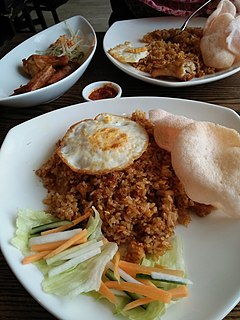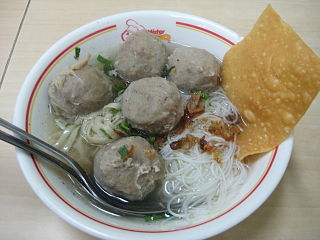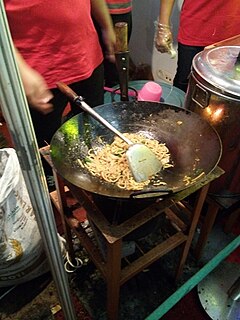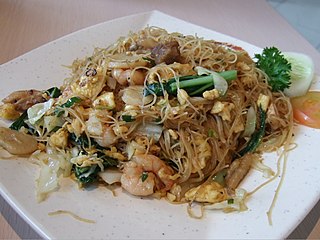
Chinese Indonesian cuisine is characterized by the mixture of Chinese with local Indonesian style. Chinese Indonesians, mostly descendant of Han ethnic Hokkien speakers, brought their legacy of Chinese cuisine, and modified some of the dishes with the addition of Indonesian ingredients, such as kecap manis, palm sugar, peanut sauce, chili, santan and local spices to form a hybrid Chinese-Indonesian cuisine. Some of the dishes and cakes share the same style as in Malaysia and Singapore which are known as the Nonya cuisine by the Peranakan.

Nasi goreng is a Southeast Asian fried rice dish, usually cooked with pieces of meat and vegetables. One of Indonesia's national dishes, it is also endemic in Malay-speaking communities in countries such as Malaysia, Singapore and Brunei, and has gained popularity in Sri Lanka through migrations from the Malay Archipelago, in countries like Suriname via Indonesian immigrant communities, and in the Netherlands through its colonial ties with Indonesia. Nasi goreng is distinguished from other Asian fried rice preparations by its distinct smoky aroma, and caramelised yet savoury undertones of flavour. There is no single defined recipe for nasi goreng, and its composition and preparation varies greatly from household to household.

Fried noodles are common throughout East Asia, Southeast Asia and South Asia. Many varieties, cooking styles, and ingredients exist.

Mie kuah, literally "noodle soup", or also known as mie rebus/mi rebus or mee rebus, literally "boiled noodles", is a Maritime Southeast Asian noodle soup dish, and popular in Maritime Southeast Asia countries such as Indonesia, Malaysia, Singapore.

Bakmi or bami is a type of wheat based noodles derived from Chinese cooking tradition. It was brought to Southeast Asia by Chinese immigrants from Southern Chinese provinces like Fujian. It is typically prepared seasoned in soy sauce and topped with pork products, which is often substituted for other protein sources in predominantly Muslim Indonesia. Chinese-style wheat noodles has become one of the most common noodle dishes, especially in Southeast Asian countries which have significant Chinese populations and known by various names.

Mie goreng, also known as bakmi goreng, is an Indonesian style of stir fried noodle dish. It is made with thin yellow noodles stir fried in cooking oil with garlic, onion or shallots, fried prawn, chicken, beef, or sliced bakso (meatballs), chili, Chinese cabbage, cabbages, tomatoes, egg, and other vegetables. Ubiquitous in Indonesia, it is sold by food vendors from street-hawkers, warungs, to high-end restaurants.

Lor mee is a Hokkien noodle dish from Zhangzhou served in a thick starchy gravy. Variants of the dish are also eaten by Hokkiens in Singapore, Indonesia and Malaysia. In the Philippines, the local variant is called Lomi or Pancit Lomi. The thick gravy is made of corn starch, spices, meat, seafoods and eggs. The ingredients added into the noodles are usually ngo hiang, fish cake, fish, round and flat meat dumplings, half a boiled egg, and other items depending on the stall and the price paid. Vinegar and garlic can be added as an optional item. Lor Mee can be served together with red chili. Traditional versions also include bits of fried fish as topping though few stalls serve this version anymore.

Indomie is a brand of instant noodle produced by the Indonesian company Indofood. Indofood itself is the largest instant noodle producer in the world with 16 factories. Over 15 billion packets of Indomie are produced annually. Indomie is also exported to more than 90 countries around the world. Indofood's key export markets are Australia, India, Iraq, Papua New Guinea, Hong Kong, East Timor, Jordan, Saudi Arabia, the United States, New Zealand, Taiwan, Egypt, Syria, and countries in Europe, Africa, the Middle East and Asia. Indomie has been produced mainly in Indonesia since it was first introduced in 1972, though Indomie has also been produced in Nigeria since 1995. Indomie has also been increasingly popular in Nigeria and other African countries.

Bakso or baso is an Indonesian meatball, or a meat paste made from beef surimi. Its texture is similar to the Chinese beef ball, fish ball, or pork ball. The word bakso may refer to a single meatball or the complete dish of meatball soup. Mie bakso refers to bakso served with yellow noodles and rice vermicelli, while bakso kuah refers to bakso soup served without noodles.

Kwetiau goreng is an Indonesian style of stir fried flat rice noodle dish. It is made from noodles, locally known as kwetiau, which are stir fried in cooking oil with garlic, onion or shallots, beef, chicken, fried prawn, crab or sliced bakso (meatballs), chili, Chinese cabbage, cabbages, tomatoes, egg, and other vegetables with an ample amount of kecap manis. In Asia, kwetiau is available in two forms, dried and fresh. Its recipe is quite similar to another Chinese Indonesian favourite, mie goreng, with the exception of replacing yellow wheat noodles for flat rice noodles.

Mie aceh or mi aceh is an Acehnese curried spicy noodle dish.

Mie jawa, also called as mi jawa or bakmi jawa in Indonesia, or mee Jawa in Malaysia is a traditional Javanese style noodle, commonly found in Indonesia and Malaysia. The dish is made of yellow noodle, chicken, vegetables, egg and spices. The recipe however, is slightly different between mie jawa in Indonesia and mee Jawa in Malaysia.

Mie Gomak is a Batak thick spicy noodle soup dish served in a coconut milk and andaliman-based broth, specialty of Toba Batak region of North Sumatra, Indonesia. Other that traditional Batak lands surrounding Lake Toba, this dish is also a specialty of the Sibolga and Tapanuli area. Unlike common Indonesian noodles, the type of noodle used in this dish is a thick one called mie lidi, quite similar to spaghetti pasta, thus mie gomak is often described as Batak style spaghetti. Mie gomak is quite similar to Mie Aceh from neighbouring province.

Acehnese cuisine is the cuisine of the Acehnese people of Aceh in Sumatra, Indonesia. This cuisine is popular and widely known in Indonesia. Arab, Persian, and Indian traders influenced food in Aceh although flavours have substantially changed their original forms. Combination of spices in Acehnese cuisine just as are commonly found in Indian and Arab cuisine, such as ginger, pepper, coriander, cumin, cloves, cinnamon, cardamom and fennel. A variety of Acehnese food is cooked with curry or coconut milk, which is generally combined with meat such as buffalo, beef, goat meat, lamb, mutton, fish, or chicken.

Kwetiau ayam, kuetiau ayam or sometimes kwetiau ayam kuah is a common Chinese Indonesian dish of seasoned flat rice noodles topped with diced chicken meat. It is often described as a kwetiau version of the popular mie ayam, and especially common in Indonesia, and can trace its origin to Chinese cuisine.

Indonesian noodles are a significant aspect of Indonesian cuisine which is itself very diverse. Indonesian cuisine recognizes many types of noodles, with each region of the country often developing its own distinct recipes.

Mie bakso is an Indonesian noodle soup dish consists of bakso meatballs served with yellow noodles and rice vermicelli. This dish well known in Chinese Indonesian, Javanese and Malay cuisine. Mie bakso is almost identical with soto mie, only this dish has meatball instead of slices of chicken meat.

Bihun goreng, bee hoon goreng or mee hoon goreng refers to a dish of fried noodles cooked with rice vermicelli in both the Indonesian and Malay languages. In certain countries, such as Singapore, the term goreng is occasionally substituted with its English equivalent for the name of the dish.
![Mie Caluek Grong Grong - my chlwq [?]rwGH2.jpg](http://upload.wikimedia.org/wikipedia/commons/thumb/1/1b/Mie_Caluek_Grong_Grong_-_%D9%85%D9%8A_%DA%86%D8%A7%D9%84%D9%88%D9%82_%DD%A2%D8%B1%D9%88%DA%A0%D9%A2.jpg/250px-Mie_Caluek_Grong_Grong_-_%D9%85%D9%8A_%DA%86%D8%A7%D9%84%D9%88%D9%82_%DD%A2%D8%B1%D9%88%DA%A0%D9%A2.jpg)

















